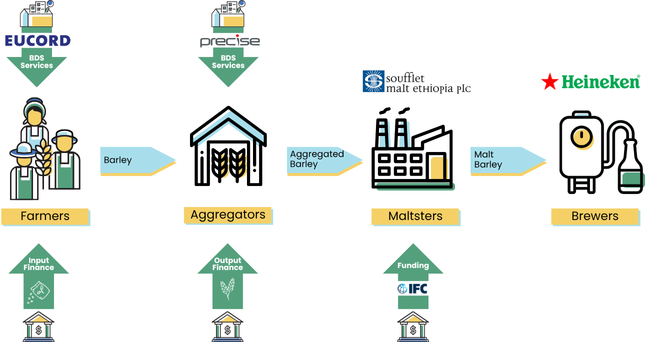In just one decade, Ethiopia’s barley value chain achieved a remarkable transformation—moving from import dependence to becoming a net exporter. This success story, documented in AMEA’s latest Learning into Action case study, demonstrates the power of coordinated investment in processing facilities, aggregator capacity building, and comprehensive business development services (BDS).
The IFC-Soufflet ET Advisory Services Project Phase I represents a compelling example of how strategic partnerships can drive systemic change. Co-financed by IFC and GAFSP with a $2 million advisory investment, the project supported Soufflet’s $20 million malting plant investment, creating an integrated approach that delivered exceptional results:

At the heart of this transformation was the Agribusiness Leadership Program (ALP), which provided comprehensive BDS to 100 agri-SMEs including aggregators, cooperatives, and model farmers. The program’s blended delivery model—combining in-person sessions, mobile coaching, and SMS-based reinforcement—proved highly effective in building aggregator capacity.
The numbers tell a compelling story: for every $1 invested in BDS support, aggregators generated an additional $183 in turnover. When calculated against the full integrated package cost (including agronomy support and input financing), the return remained impressive at $27 in turnover per $1 invested.
1. Cost-effectiveness must be calculated using the cost of the full integrated package
2. A robust approach to segmenting and tailoring BDS in Phase II should be developed
3. Cost-share to build a culture of paying for ALP services
4. Invest in flexible, resilient BDS approaches
5. Improve data collection to track agronomy improvements
6. Improve co-operative decision making speed
7. Expand ePayment services as mobile coverage improves
8. Strategy development for gender equity improvement
9. Assess trade-off between efficiency & Impact
10. Conscious effort to disseminate learning to inspire other malters
As Phase II of the project begins with expansion to new areas and a more efficient delivery model, the lessons learned offer valuable insights for maltsters, aggregators, and development practitioners across Africa and beyond. The conscious effort to disseminate these learnings will be crucial for inspiring other value chain actors to adopt similar integrated approaches.
The Ethiopian barley value chain transformation demonstrates that with the right combination of strategic investment, capacity building, and coordinated partnerships, it’s possible to create sustainable change that delivers real value for farmers while building resilient supply chains.
For all the latest about our work and updates about our partners, signup for our newsletter.
We use cookies on our website to give you the most relevant experience by remembering your preferences and repeat visits. By clicking “Accept All”, you consent to the use of ALL the cookies. However, you may visit "Cookie Settings" to provide a controlled consent.